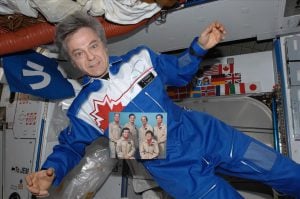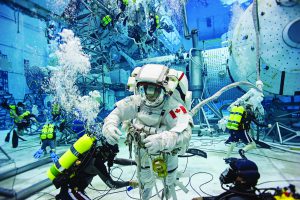
Exploration
Canadian Space Agency astronaut profiles
The men and women that have become part of Canada’s space team
- 1067 words
- 5 minutes
This article is over 5 years old and may contain outdated information.
Exploration

On the beginning
Steve and I have been together for close to 30 years. We were both adults when we met, though I was still in my twenties. We were both working at the National Research Council back then. Steve was coming back from a post docorate at Stanford and I was working for the official languages office. I think we both felt we had a special connection. We’d each met enough people in our lives to know when we met someone special. It’s like when you’re together, you don’t have to talk too much and he understands what you need, and vice versa. We moved to Houston for Steve’s first launch in 1992, then back to Ottawa, then back to the States in 1995 to train for his second launch. He ended up flying in 2006.
On Houston
The first time we moved to Houston, we had a six-month-old baby and a two-year-old. I was on maternity leave, and it was clear we were going to Houston for more-or-less a year. The timing was perfect for us in terms of my own career.
The second time, NASA was inviting international astronauts to fly as mission specialists, so we were in Houston for about a decade while Steve trained. By this time, we had three children: two in high school, one in elementary. So they understood what their father was doing. They were very curious and so easy-going, which really helped. In the neighbourhood where we were living, many people were working in the space program. We met people and astronauts from all over the world. Our friends were from Germany, from Spain, from Sweden, from the United States. We understood the dangers, but at the same time, we understood the purpose of flying to space and felt like it was bigger than us. I had two choices: either embrace the mission and what Steve does, or sit alone and remain afraid. We decided to go full integration. It was, overall, a great adventure.
Of course, it was also extremely busy and challenging. Steve was training long hours, and often had to train in different cities because some of the activities and training involved were very time consuming. It was a swirl of activities, training and travelling. Our whole family was a part of that. Sometimes we went along to the simulations with Steve. To the children, being an astronaut-in-training was just another job, albeit an exciting one. At dinner, we’d talk about what he’d done that day, but then we’d move onto my day, or the kids’ day, or what was going on in the world. That’s what I remember most: all the interesting conversations.
On the dangers
We had close friends aboard the Columbia flight when it exploded. Our families had traveled together and our kids were the same age. We’d spent endless nights chatting over a glass of wine while the kids played in the pool. I guess watching Steve launch into space after that is one of the hardest things I’ve ever had to do. I get emotional just talking about it. During lift-off, there are some crucial moments when you know the danger is much more serious. And the children know those moments too. But once that moment has passed, you can check it off your list. We watched from a special area for the immediate families. The space agencies are supporting you and take safety very seriously. You try to stay positive; you know this is what your spouse wants to do. Once they’re aboard the space station it’s a bit better.
Now, eight years later, our entire community isn’t involved in the space mission and I’ve had a chance to reflect and realize the risk a bit more. Maybe it’s because I’m older. Back then, when you’re in the action, it’s so intense and there’s so much going on that you have no choice but to stay focused. You are in a bubble, and it’s comfortable remaining in that bubble.
On post-space
When he landed the second time, we’d been in Florida for three weeks because the launch had been delayed. The kids were maybe 16, 14, and 13. So when Steve landed, within a couple of hours we were able to see him. The kids were so excited to see him, but they just wanted to talk about what they had been doing. Steve and I just looked at each other, and were like ‘hey kids I just came back from something pretty special, I’ve got things to say too.’ But for the first 15 minutes, it was just the kids talking. It was one of the funniest moments of our lives.
That first day, Steve was a little bit fragile; he had trouble standing without leaning on a wall. But once he’d gone through all the physical exams, we had a big gathering at the condo we were living in and Steve was able to share his feelings. After that, you gradually sink back into routine. Every once in a while, something will come up in conversation that will bring back a memory to share, but overall, life goes back to normal.
Our relationship didn’t change in any way. True, when you share such an intense experience, it’s a bonding experience. It’s a special moment that nobody can take away from you. But it’s not the only thing you have in life.
On making it work
We share many common values. Things like family, respect, curiosity and friendship. A sense of humour is also very important, and not taking ourselves too seriously. He’s my best friend, and I know I’m his; that was very important. We’ve had disagreements, of course, but it’s a 50-50 compromise. He has to agree that certain things like my career or desire to go back to school are important to me–and he does.
Advice for partners of Canadian astronauts
Share the experience. Share the learning. Keep the perspective big and remember that it’s a team effort. Stay grounded. Invest yourself and embrace it, but make it clear that you (as a spouse) also have aspirations and goals. Give equal importance to other, non-space aspects of life. Life has so much to offer and I think it’s important to experience as much as you can, share as much as you can and love as much as you can.
— As told to Sabrina Doyle
Are you passionate about Canadian geography?
You can support Canadian Geographic in 3 ways:

This story is from the October 2014 Issue

Exploration
The men and women that have become part of Canada’s space team

Exploration
The significant CSA events since Alouette’s launch

Science & Tech
From enduring extreme isolation and psychological strain to operating high-tech robotics and undergoing an intense physical fitness regimen, here’s a glimpse at what it takes to head to space

People & Culture
This year’s roster of Gold Medal recipients at The Royal…